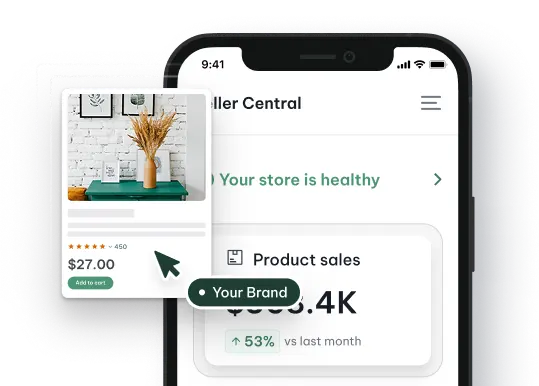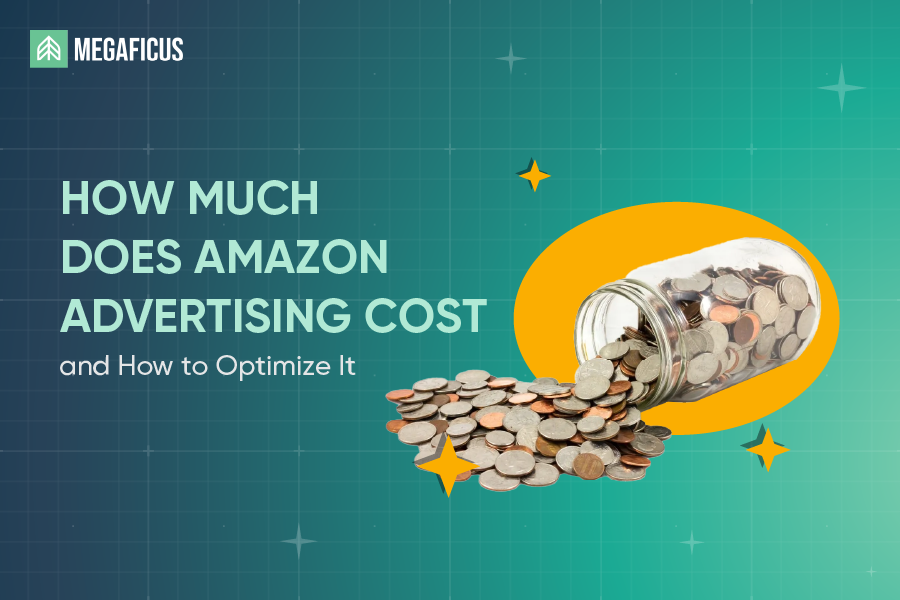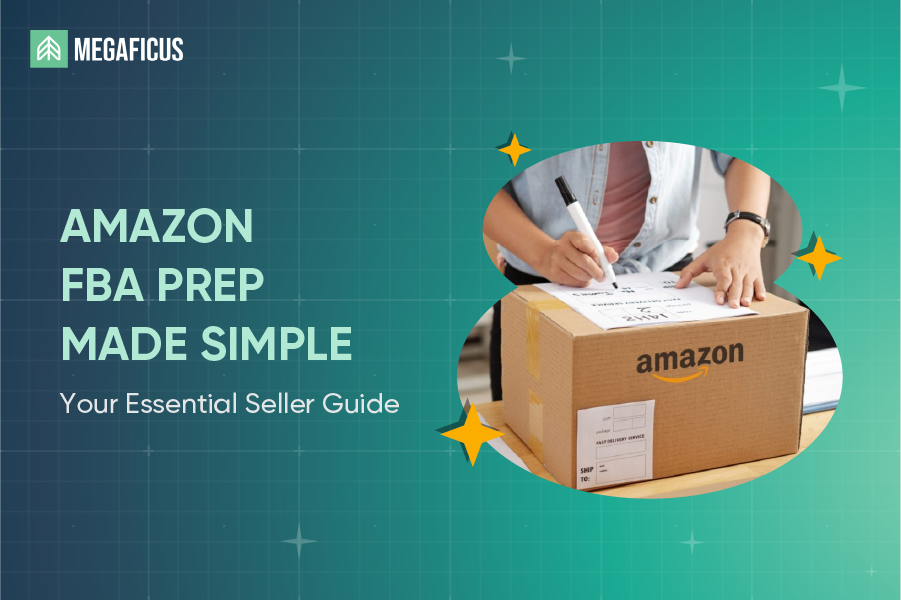Ever ask yourself how much does Amazon advertising cost and why sellers keep talking about ROI? This detailed guide from Megaficus will break down Amazon advertising costs, explain what influences your spending, and give step-by-step tactics to manage your advertising costs on Amazon for better profitability.
Quick Summary
- Amazon advertising cost: Typically ranges from $0.75-$1.50 CPC, depending on ad type, category, and keyword competition.
- Key metrics: ACoS (20-30%), ROAS (3x+), and ROI (200-350%) measure how efficiently ad spend drives revenue.
- Main cost factors: Product category, keyword competition, listing quality (CTR & CVR), and seasonal surges.
- Optimization tips: Use negative keywords, refine bidding, enhance SEO, and track with tools like Helium 10 Adtomic or Amazon Ads Console.
- Budget guideline: Allocate 10-20% of monthly sales for testing, review performance weekly, and rebalance spend across ad types for steady ROI growth.
What Is Amazon Advertising Cost & Why It Matters
Before diving into numbers, it’s important to understand what Amazon advertising cost actually means for sellers. In essence, it refers to how much sellers pay Amazon to promote their products through different ad formats such as Sponsored Products, Sponsored Brands, or Sponsored Display.
Understanding Amazon Advertising Cost
Amazon mainly uses two pricing models: CPC (Cost-Per-Click) and CPM (Cost-Per-Mille).
- With CPC, you pay only when someone clicks your ad.
- With CPM, you’re charged per 1,000 ad impressions, no matter if users click or not.
Most Amazon campaigns, especially Sponsored Products, operate on the CPC model, where you bid against other sellers for keyword placements and you only pay when someone clicks your ad.


The actual cost of Amazon advertising depends on how competitive your category and keywords are. For instance, Beauty & Skincare ads average $0.80 – $1.20 per click, while Electronics range from $1.00 – $1.60. Less competitive niches like Home & Kitchen typically cost $0.60 – $1.00 per click.
These numbers show that Amazon’s advertising cost fluctuates depending on demand and competition. For instance, high-margin categories like electronics or supplements tend to have higher CPC rates due to aggressive bidding.
If you’re asking how much it costs to advertise on Amazon, most new sellers spend between $500 – $3,000 monthly during their first campaigns. Once optimized, those campaigns can generate steady organic visibility and repeat customers.
Why does the Cost matter?
Understanding why the cost matters helps sellers make smarter advertising decisions. Amazon advertising cost directly influences your profit margins, visibility, and overall growth. When you know how much each click or impression is worth, you can allocate budget efficiently and avoid overspending.
Amazon ads work like a flywheel. The more visibility you gain through ads, the more clicks and sales you get. Those sales signal to Amazon that your product is relevant, which helps your organic ranking rise. In turn, your Amazon advertising cost goes down after some time because your listing becomes self-sustaining.
ROI, or Return on Investment, is the foundation of every advertising decision on Amazon. It measures how much revenue your ads generate compared to how much you spend.
A healthy ROI should be above 200%; however, a 100-150% ROI is also common among new sellers still testing campaigns or competing in high-CPC categories like electronics or supplements.

Amazon advertising cost also matters when it affects visibility. To compare paid versus organic visibility, paid ads provide instant exposure at a cost per click, while organic visibility builds gradually through optimized listings and consistent sales performance.
When your Amazon advertising cost is well-optimized, it boosts paid visibility first and helps your products appear in top search positions to attract more clicks. In the long run, that increased engagement signals to Amazon that your product is relevant, which improves your organic rankings.
As your organic visibility grows, you rely less on paid ads to maintain sales, effectively lowering your long-term advertising costs while sustaining higher overall visibility and profitability. So, the smarter you spend on ads early on, the faster your products gain organic traction, creating a self-sustaining loop where visibility drives sales, and sales reduce future ad costs.
What Factors Affect Amazon Advertising Costs
Several variables influence advertising cost on Amazon, as each category behaves differently depending on demand, competition, and customer intent. However, four major factors consistently determine how much sellers pay for visibility, and understanding them helps you manage ad budgets more effectively.

1. Product category and keyword competition
Different categories on Amazon have vastly different CPC averages. Highly competitive niches like home & kitchen, supplements, and beauty often attract more sellers bidding on the same terms, driving the cost upward.

For instance, keywords like “cooking accessories” or “vitamin C serum” can exceed $1.50 per click, while niche items such as “handmade candles” or “wooden bookmarks” might stay under $0.50 per click. The greater the competition, the higher you must bid to stay visible.
2. Keyword difficulty
Keywords with high search volume or generic intent generally cost more because everyone wants to rank for them. Smart advertisers must balance both types by using high-volume terms for reach and low-cost niche keywords for profitability.
For example, broad terms like “air fryer chicken wings” or “skincare serum” face fierce bidding wars, while longer-tail, specific searches like “noise-canceling Bluetooth earbuds” or “vitamin C brightening serum” are often cheaper and convert better.
3. Listing quality (CTR and CVR)
Amazon’s algorithm rewards listings that deliver results. When your product earns strong CTR and CVR, Amazon interprets it as highly relevant to shoppers, reducing your cost per click. On the other hand, if your ad gets clicks but few sales, Amazon may charge more to maintain exposure.

4. Seasonality and traffic surges
Ad costs also fluctuate throughout the year based on shopping demand. During Prime Day, Black Friday, or Q4 holidays, CPC rates can rise by 30 – 50% as more sellers compete for limited ad placements. If you don’t plan your seasonal budget early, you may end up overspending for visibility.
How Much Does Amazon Cost Per Click Advertising Vary by Ad Type
If you’re wondering why some campaigns drain your budget faster than others, the reason often lies in ad type. Each Amazon ad format has a unique purpose and its own price tag.
| Ad Type | Average CPC | Typical Purpose |
|---|---|---|
| Sponsored Products | $0.75 – $1.25 | Direct sales & keyword targeting |
| Sponsored Brands | $1.00 – $1.50 | Brand awareness & store traffic |
| Sponsored Display | $0.60 – $1.20 | Retargeting & cross-promotion |
For example, you have a home décor brand promoting “ceramic plant pots” that runs all three campaign types. Sponsored Products drives immediate sales, Sponsored Brands builds recognition, and Sponsored Display re-engages visitors who viewed but didn’t buy. Combined, these campaigns deliver balanced exposure while still keeping your CPC costs optimized.

If you wonder how much Amazon advertising costs per day, Megaficus advises sellers to usually set budgets between $20 – $50 daily for Sponsored Products and $30 – $60 for Sponsored Brands. As time goes on, performance data helps refine which ad type offers the best return.
How to Optimize Advertising Cost on Amazon
Good advertising doesn’t always mean high spending. It’s about making your budget go further. Sellers who analyze performance, refine targeting, and use data-backed adjustments can lower costs while maintaining sales growth. Below are the most effective ways to reduce advertising costs on Amazon without sacrificing visibility or performance.
1. Use negative keywords smartly
Negative keywords are essential for eliminating wasted spend. They block your ads from showing in irrelevant searches, ensuring your budget reaches buyers who actually convert.
For example, if you sell a premium “vitamin C serum,” excluding terms like “cheap vitamin C serum” or “DIY skincare” prevents low-quality clicks. Over time, this improves ACoS, raises conversion rates, and strengthens targeting accuracy.
2. Refine targeting and bidding
Precise targeting allows you to control who sees your ads and how much you pay for each click. Switching from automatic to manual campaigns helps you identify which keywords truly drive sales. You should gradually adjust your bids based on performance: lower them for keywords that underperform and increase them for those consistently driving conversions and sales.

For instance, if you bid $0.90 for “organic vitamin C serum” but $1.30 for “vitamin C serum for face,” you may find the latter delivers better returns per click.
3. Improve listing SEO
Optimizing your listing’s SEO can significantly reduce your CPC because Amazon rewards high-performing listings with lower bid prices. So you’d better focus on crafting keyword-rich titles, clear bullet points, and persuasive A+ content that highlights benefits.
Moreover, strong visuals paired with consistent, positive reviews often signal reliability to both Amazon’s algorithm and potential buyers, which gradually improves CTR and CVR while maintaining cost efficiency. The more relevant and engaging your listing is, the less you’ll need to pay for the same visibility.
>>> Read more: Easy Step-by-Step Amazon SEO Checklist to Drive More Sales
4. Utilize ad tools
Ad automation and analytics tools can make campaign management more data-driven and less time-consuming. Beyond simple reporting, these tools reveal hidden trends such as which times of day or product categories deliver the most efficient conversions. They also help identify gradual shifts in keyword competitiveness that might go unnoticed in manual tracking.
We suggest using some platforms like Amazon Ads Console, Helium 10 Adtomic, and Sellics to offer real-time keyword tracking, bid adjustments, and performance dashboards. These tools help you detect overspending early, test variations faster, and allocate your budget toward the ads that actually generate real profit, but not just clicks.

Budget Guidelines for Amazon Advertising
Budgeting is where most sellers either succeed or burn through cash. If you have a clear plan, you can keep your Amazon advertising costs under control while ensuring steady performance. Our guideline below is a good reference for you to build the perfect strategy for your Amazon business.
Define Purpose
A smart budget gives you control over your ad performance and keeps spending focused on what truly drives sales. Think of it less as a cost and more as an investment that pays off over time. Every dollar should serve a clear purpose, whether it’s testing new keywords or scaling proven campaigns.
When you approach your budget strategically, it becomes not just numbers on a dashboard but a growth engine that helps you expand profitably and sustainably.

Start with a Test Budget
Testing helps you understand which ad types and placements deliver the best returns. A good starting point is to allocate 10 – 20% of monthly sales revenue for the first 2 – 4 weeks. During this phase, you should track performance closely to identify what works best.
For instance, if you earn $5,000 per month, you might begin with a $1,000 ad budget and later find that Sponsored Products drive the highest ROI, dedicating 70% of next month’s budget there.
Set Daily and Campaign Limits
Daily limits prevent overspending and help you manage cash flow across multiple campaigns. You should use the following benchmarks:
| Campaign Type | Recommended Daily Budget |
|---|---|
| Sponsored Products | $20 – $50 |
| Sponsored Brands | $30 – $60 |
| Sponsored Display | $15 – $30 |
These figures are starting points and you can adjust them based on your product category, competition, and ACoS goals. Higher-margin products may allow slightly larger daily caps, while lower-margin items benefit from tighter limits.
Optimize ROI Based on ACoS and ROAS
Monitoring ACoS, ROAS and ROI keeps your advertising cost on Amazon aligned with profitability goals. As Megaficus noted above, maintaining an ACoS between 20 – 30% and a ROAS of 3x or higher usually reflects a healthy ROI. It signals that your ad spend is generating sustainable profit rather than short-term traffic and scaling in the right direction.
Also remember that regular A/B testing of ad creatives, keyword bids, and visuals can gradually improve these metrics, too. Tracking performance shifts after each test helps you identify what truly drives conversions. Gradually, even small refinements can compound into noticeable gains in efficiency and ad profitability.

Distribute Your Budget Wisely
Balancing spend across ad types prevents dependency on a single channel. A recommended mix from Megaficus looks like this:
- 60% → Sponsored Products (for conversions and direct sales)
- 25% → Sponsored Brands (for visibility and recognition)
- 15% → Sponsored Display (for retargeting and awareness)

For most sellers, this distribution creates a stable balance between performance and awareness. It allows you to drive immediate sales through Sponsored Products while building recognition and retargeting audiences at the same time.
However, if you’re in a highly visual niche (such as beauty or fashion), you might dedicate around 35 – 40% of your budget to Sponsored Brands, since shoppers often rely on visuals when choosing skincare or cosmetics.
So the key is your flexibility in budget allocation because our mix above is just relative and not fixed for all products. You should be flexible in distribution to build brand recognition while still driving steady conversions, so that you can maintain a balance that supports both short-term sales and long-term growth.
Review and Adjust Weekly
Weekly reviews ensure your campaigns adapt quickly to performance changes. Analyzing reports in Amazon Ads Console or Helium 10 dashboards every 7 – 10 days helps you spot underperforming keywords or ad groups early.

When you’re reviewing and you see a campaign that drains spend without conversions, you can pause it and shift the budget to better-performing ads, maintaining cost efficiency as time goes by. Eventually, these consistent adjustments on your dashboard allow your campaigns to stay competitive while protecting your profit margins.
Prepare Seasonal Budget Buffers
Seasonal events like Prime Day, Cyber Monday, Black Friday, or Q4 holidays often increase CPCs by 30 – 50%. To stay competitive, Megaficus recommends that you usually raise your bids gradually before peak seasons and scale down right after, so that you can keep advertising costs on Amazon sustainable year-round.

For instance, if you sell electronics, you might choose to double your ad budget during Prime Week to compete for top visibility when shopper traffic surges. After the event, scaling back to around 70% of your usual spend helps maintain exposure while keeping profits stable.
Frequently Asked Questions About Amazon Advertising Cost
On average, between $0.75 and $1.25 for Sponsored Products. It varies depending on competition, ad type, and product category.
$20-$50/day for Sponsored Products is a safe start. Increase gradually based on conversion rate and ROI.
No. Sponsored Brands and Sponsored Display usually have slightly higher CPC than Sponsored Products due to brand positioning.
Use negative keywords, improve product listings, and monitor performance weekly. Automation tools can also optimize bids automatically.
Yes. Costs in the U.S. are generally higher than in emerging markets like India or Brazil due to stronger competition.
Get Professional Help from Megaficus
Understanding how much Amazon advertising costs is more than just looking at numbers. It’s about knowing how those numbers connect to growth. Successful sellers view ads as an investment, not an expense, using performance data to refine strategy.
By following clear budget guidelines, optimizing campaigns weekly, and tracking ACoS and ROAS, you can maintain profitable Amazon advertising costs while driving long-term visibility and sustainable sales growth.
Start optimizing your Amazon ad campaigns today with Megaficus!







